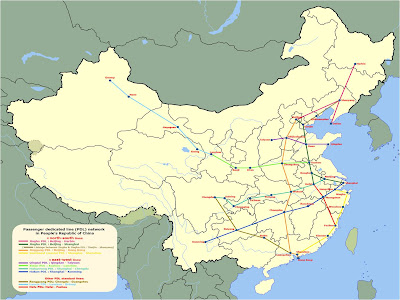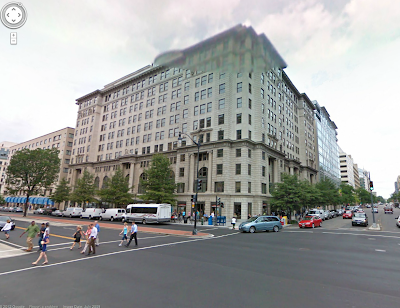 |
| The planned National High Speed Rail Network in the People’s Republic of China. |
Jie Lin, who is a colleague of mine both at the CtSDC and the Department of Geography Ph.D. program, recently examined the impacts of the planned High Speed Rail Network in the People’s Republic of China. Specifically, Jie’s focus has been on the increase in accessibility that would be a result of implementing the planned high speed network. Before we dive into Jie’s results, however, a little background.
The total area of China is comparable to the size of the United States and the majority of that land is continuous. China has varying local physical geography that can isolate places- like the mountainous region of Tibet. Consequently, the successful implementation of a transportation network with higher travel speeds and greater accessibility has consequences in the realms of culture, the economy, and the overall social fabric of the country. Greater accessibility means the spatiotemporal size of the country decreases (ie. it takes a shorter amount of time to go from A to B, thus making A and B “closer”).
But, how does one calculate accessibility? Accessibility is defined by the ease of getting from place to place in a network. It is commonly calculated using a connectivity matrix like this:
This matrix is formed by counting how many nodes one must pass through in order to get to another node in the matrix. For example, the shortest way to go from A to E, is to pass through B, C, and E, so a 3 is added to Row A, Column E. The only difference in Jie’s study is that the calculations are not based on how many nodes one must pass through, but rather the time (in hours) it takes via the shortest route. As you can see, this measure evaluates your ability to travel from each node to each and every other node in the network.
Jie’s study, which included 31 provincial capitals and administered municipalities, was based on the following assumptions:
- Speed of Normal Rail: 130 km/h
- Speed of High Speed Rail: 280 km/h
Now, to Jie’s results. The units, besides the percentage column, are in hours:
And, for those of you (like me) who prefer to communicate visually, here is the resulting map. Again, units are in hours:
One of the most interesting points that I discussed with Jie is that although there are no plans for the Tibetan Region to be served by high speed rail (it is served by normal rail), the accessibility of the city of Lhasa is increased tremendously due to the improvements in other parts of the network. In fact,
Lhasa has the greatest absolute change in accessibility out of any city in the study. It will be interesting to see this will affect
the region culturally, economically, and socially. Overall, Jie found that
the full implementation of this high speed rail network would mean an average increase in accessibility of about 50% for the cities included in the study.











